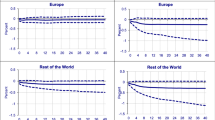Abstract
This paper proves the co-movement of foreign trade in different countries or areas which belong to ten economic regions by MS-VAR model. The studies show that trade crisis lags behind economic crisis and spreads from the core of the economic crisis to its periphery which is closely-related with it. The trade crisis corresponding to the US subprime crisis spreads faster than before, which has struck worldwide foreign trade. In order to get the main factors affecting trade crisis, the authors construct composite indices which are proxies of economic growth and price levels of internal and external regions. The results of logistic and linear panel models show that economic growth affects more to trade cycle than price level. The results of panel models with dummy variable of trade crisis show that the outside economic growth do bad to the recovery of internal foreign trade during trade crisis corresponding to Mexican peso crisis, the Asian financial crisis and the Russian debt crisis, while the opposite is true during the internet bubble burst and the US subprime crisis.
Similar content being viewed by others
References
Krolzig H M, Markov-Switching Vector Autoregressions: Modelling, Statistical Inference, and Application to Business Cycle Analysis, Springer, Berlin, 1997.
Hamilton J D, A new approach to the economic analysis of nonstationary time series and the business cycle, Econometrica: Journal of the Econometric Society, 1989, 57(2): 357–384.
Krolzig H M, Business cycle measurement in the presence of structural change: International evidence, International Journal of Forecasting, 2001, 17(3): 349–368.
Artis M, Krolzig H M, and Toro J, The European business cycle, Oxford Economic Papers, 2004, 56(1): 1–44.
Altavilla C, Do EMU members share the same business cycle?, JCMS: Journal of Common Market Studies, 2004, 42(5): 869–896.
Altissimo F, Bassanetti A, Cristadoro R, et al., EuroCOIN: A real time coincident indicator of the euro area business cycle, CEPR Discussion Paper, 2002, No. 3108.
Diebold F X and Rudebusch G D, Measuring business cycles: A modern perspective, Review of Economics and Statistics, 1996, 78: 67–77.
Stock J H and Watson M W, New Indexes of Coincident and Leading Economic Indicators, MIT Press, 1989.
Kose M A, Otrok C, and Whiteman C H, International business cycles: World, region, and country-specific factors, American Economic Review, 2003, 93(4): 1216–1239.
Mumtaz H and Surico P, Evolving international inflation dynamics: Evidence from a time-varying dynamic factor model, Centre for Economic Policy Research Discussion Paper, 2008.
Tong D and Zhang W B, Business cycle’s synchronization in East Asia, World Economy Study, 2009 8: 82–88.
Groth A, Ghil M, Hallegatte S, et al., Evidence for genuine periodicity and deterministic caused of US business cycles, Submitted to Econometrica, 2009.
Zhen Y L, Analysis of the fluctuations of China’s import growth: 1979–2008, International Economics and Trade Research, 2010, 2: 12–16.
Zheng G H and Zhao L, The multi-dimentional anslysis of Chinese trade cycle-the construction of multi-dimentioanal index and the application of multi-dimentional analysis method, Journal of Systems Science and Mathematical Sciences, 2011, 2: 101–114.
Ting D, The international trade shocks and the China’s business cycle, Journal of International Trade, 2006, 12: 14–19.
Lang L H and Zhang L C, The relationship between Chinese economic cycle and foreign trade cycle, Economic Perspectives, 2011, 11: 26–32.
Canova F and Dellas H, Trade interdependence and the international business cycle, Journal of International Economics, 1993, 34(1–2): 23–47.
Frankel J A and Rose A K, The endogeneity of the optimum currency area criteria, The Economic Journal, 1998, 108(449): 1009–1025.
Calderon C, Chong A, and Stein E, Trade intensity and business cycle synchronization: Are developing countries any different, Journal of International Economics, 2002, 71(1): 2–21.
Inklaar R, Jong-A-Pin R, and De Haan J, Trade and business cycle synchronization in OECD countries — A re-examination, European Economic Review, 2008, 52(4): 646–666.
Shin K and Wang Y, Trade integration and business cycle synchronization in East Asia, Asian Economic Papers, 2003, 2(3): 1–20.
Desheng Y, The exchange rate and income elasticity of China’s trade balance, World Economy Study, 2004, 11: 49–55.
Lü Y H, Influence factors of China import and export trade flows — Empirical study on trade gravity model by panal data, Economic Problems, 2009, 10: 31–33.
Ba S S, Wu B, and Zhu Y Q, Measurement of EER of RMB and its effect on international trade and forex, Studies of International Finance, 2007, 4: 57–63.
Krolzig H M and Toro J, Classical and modern business cycle measurement: The European case, Spanish Economic Review, 2005, 7(1): 1–21.
Bengoechea P, Camacho M, and Perez-Quiros G, A useful tool for forecasting the Euro-area business cycle phases, International Journal of Forecasting, 2006, 22(4): 735–749.
Perlin M, Ms regress — The Matlab package for Markov regime switching models, Working Paper, Federal University of Rio Grande do Sul, 2010.
Author information
Authors and Affiliations
Corresponding author
Additional information
This paper was recommended for publication by Editor WANG Shouyang.
Rights and permissions
About this article
Cite this article
Zhang, L., Zhang, X. & Cheng, K. Construction and analysis of common foreign trade cycle based on MS-VAR: An empirical study of global experience. J Syst Sci Complex 28, 360–380 (2015). https://doi.org/10.1007/s11424-015-3270-6
Received:
Published:
Issue Date:
DOI: https://doi.org/10.1007/s11424-015-3270-6




